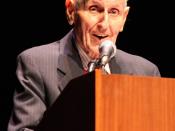Euthanasia
Imagine your grandpa is in the hospital because his Parkinson's disease has gotten worse. He may be shaking compulsively, and not be able to talk, yet inside your grandpa loves being able to sit in bed and watch the sunrise in the morning. He loves it when the attractive nurse comes in to talk to him every morning and feeds him jell-o. He loves it when you come visit him and tell him what's going on in your life. Now he's gone because his doctor didn't see how happy he was inside, and took it upon himself to kill your grandpa. The doctor it explains it to be a mercy killing, technically known as euthanasia.
It is estimated that more than 5,000 people die each year in the U.S. from euthanasia. Euthanasia is defined as intentionally making someone die, rather than allowing them to die naturally. Of those 5,000 that die, 2,000 of the deaths are estimated to have been "active" deaths (by injection or suffocation), while the other 3,000 were killed by having their life-support systems disconnected.
About half of these killings were not even for terminally ill patients, just people who were in great pain. Oregon, the Netherlands, and Belgium are the only jurisdictions in the world where euthanasia or assisted suicide is permitted. In the Netherlands, it was reported that 9% of all deaths were carried out by doctors, and half of these were cases where the patient was killed without his consent. Isn't it the primary obligation of the medical profession to preserve life, not end it? A person's life is to be treated with respect. It has always been a choice for a patient to have their life-support system disconnected, but no one should be murdered by injection or pills. Euthanasia is illegal in...


